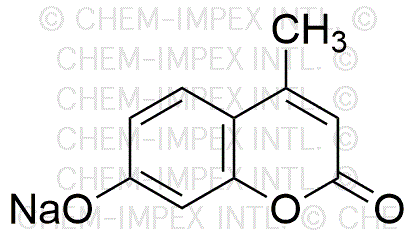4-Methylumbelliferone sodium salt is widely utilized in research focused on:
- Fluorescent Probes: This compound is often used as a fluorescent marker in biological assays, allowing researchers to visualize cellular processes and track biomolecules in real-time.
- Enzyme Activity Studies: It serves as a substrate for various enzymes, particularly in studies involving glucuronidation, helping scientists understand metabolic pathways and enzyme kinetics.
- Antioxidant Research: The compound is investigated for its potential antioxidant properties, making it relevant in studies aimed at combating oxidative stress in cells.
- Drug Development: Its role in inhibiting certain enzymes makes it a candidate for developing new therapeutic agents, particularly in cancer research where enzyme modulation is crucial.
- Cellular Imaging: Researchers use it in imaging techniques to enhance the visibility of cellular structures, aiding in the study of cell morphology and function.
General Information
Properties
Safety and Regulations
Applications
4-Methylumbelliferone sodium salt is widely utilized in research focused on:
- Fluorescent Probes: This compound is often used as a fluorescent marker in biological assays, allowing researchers to visualize cellular processes and track biomolecules in real-time.
- Enzyme Activity Studies: It serves as a substrate for various enzymes, particularly in studies involving glucuronidation, helping scientists understand metabolic pathways and enzyme kinetics.
- Antioxidant Research: The compound is investigated for its potential antioxidant properties, making it relevant in studies aimed at combating oxidative stress in cells.
- Drug Development: Its role in inhibiting certain enzymes makes it a candidate for developing new therapeutic agents, particularly in cancer research where enzyme modulation is crucial.
- Cellular Imaging: Researchers use it in imaging techniques to enhance the visibility of cellular structures, aiding in the study of cell morphology and function.
Documents
Safety Data Sheets (SDS)
The SDS provides comprehensive safety information on handling, storage, and disposal of the product.
Product Specification (PS)
The PS provides a comprehensive breakdown of the product’s properties, including chemical composition, physical state, purity, and storage requirements. It also details acceptable quality ranges and the product's intended applications.
Certificates of Analysis (COA)
Search for Certificates of Analysis (COA) by entering the products Lot Number. Lot and Batch Numbers can be found on a product’s label following the words ‘Lot’ or ‘Batch’.
*Catalog Number
*Lot Number
Certificates Of Origin (COO)
This COO confirms the country where the product was manufactured, and also details the materials and components used in it and whether it is derived from natural, synthetic, or other specific sources. This certificate may be required for customs, trade, and regulatory compliance.
*Catalog Number
*Lot Number
Safety Data Sheets (SDS)
The SDS provides comprehensive safety information on handling, storage, and disposal of the product.
DownloadProduct Specification (PS)
The PS provides a comprehensive breakdown of the product’s properties, including chemical composition, physical state, purity, and storage requirements. It also details acceptable quality ranges and the product's intended applications.
DownloadCertificates of Analysis (COA)
Search for Certificates of Analysis (COA) by entering the products Lot Number. Lot and Batch Numbers can be found on a product’s label following the words ‘Lot’ or ‘Batch’.
*Catalog Number
*Lot Number
Certificates Of Origin (COO)
This COO confirms the country where the product was manufactured, and also details the materials and components used in it and whether it is derived from natural, synthetic, or other specific sources. This certificate may be required for customs, trade, and regulatory compliance.


